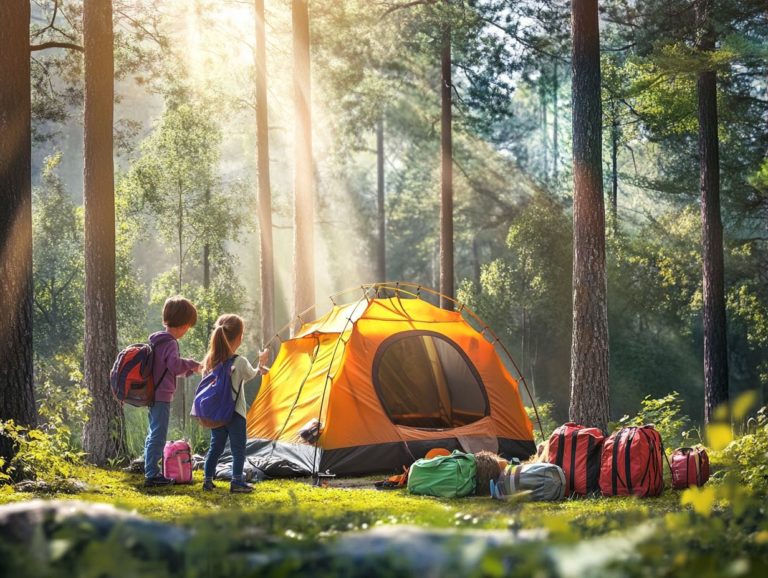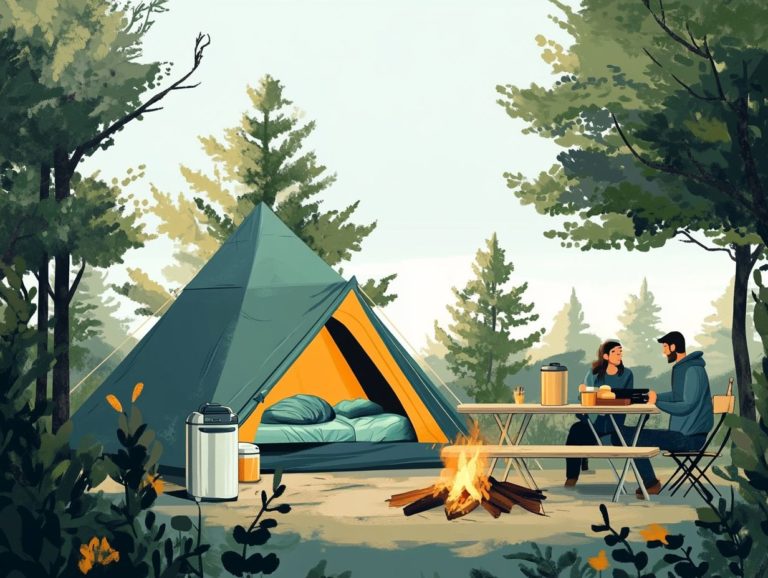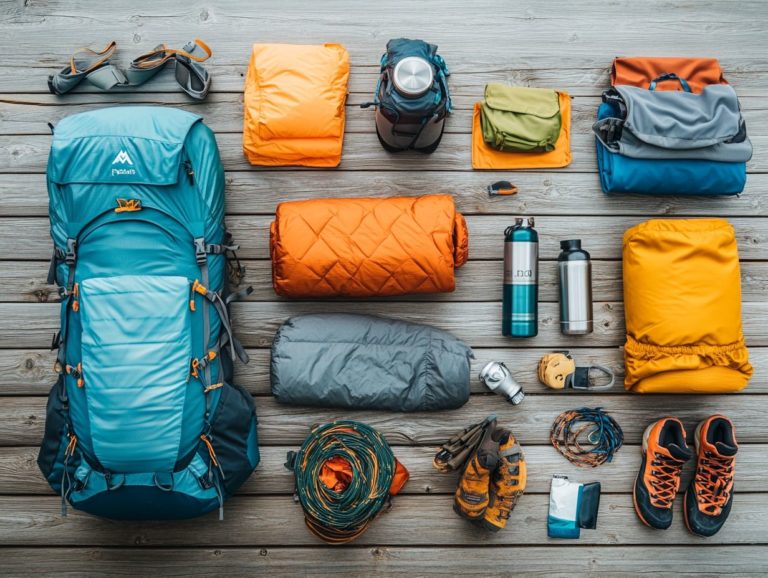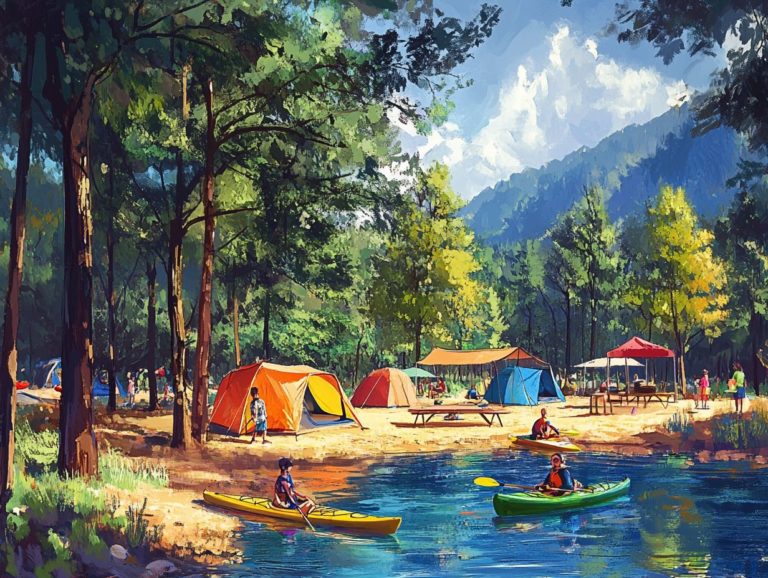How to Choose the Right Hammock for Camping
Camping enthusiasts like you are always seeking ways to elevate your outdoor adventures. Hammocks present an amazing solution, especially for those embarking on summer hiking trips along the Appalachian Trail.
This guide explores the benefits of using a hammock for camping. It covers everything from comfort to portability, making hammocks ideal for both day use and backcountry camping.
You will discover various types of hammocks, compare materials and designs, and learn essential considerations to help you select the perfect one.
The guide also covers the setup process and shares invaluable tips for maximizing your comfort and safety. You will also find maintenance advice to keep your hammock in prime condition for future excursions.
Whether you are a seasoned camper or just starting out, this guide will help you embrace the joys of hammock camping!
Contents
- Key Takeaways:
- Benefits of Using a Hammock for Camping
- Types of Hammocks
- Considerations for Choosing a Camping Hammock
- Setting Up Your Hammock
- Tips for Comfort and Safety
- Maintenance and Care of Camping Hammocks
- Frequently Asked Questions
- What are the key factors to consider when choosing a hammock for camping?
- What materials should I look for in a camping hammock?
- What weight capacity should I choose for a camping hammock?
- How do I determine the right size for a camping hammock?
- What are the different types of suspension systems for camping hammocks?
- Are there any additional features I should look for in a camping hammock?
Key Takeaways:
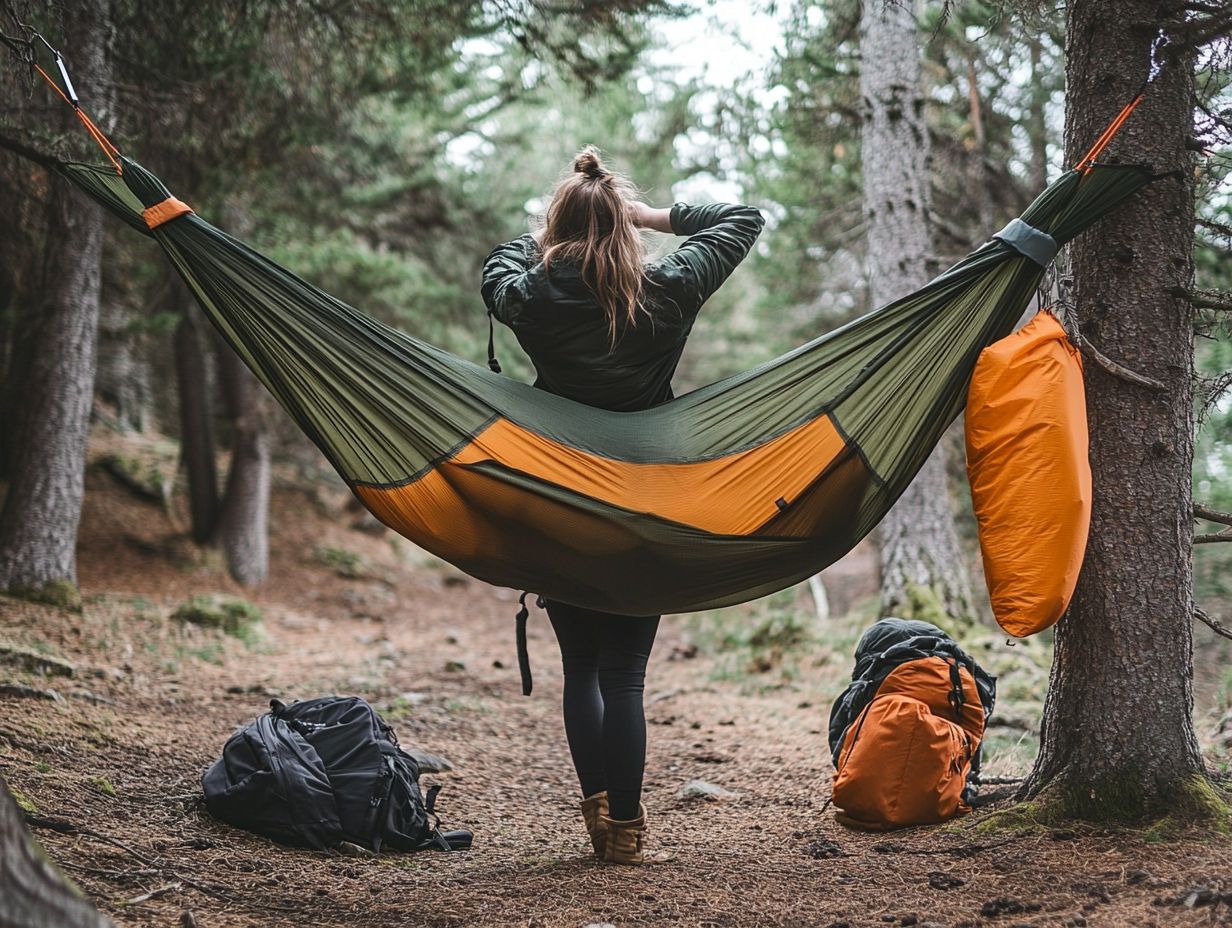
- Select a camping hammock that fits your needs. Think about size, weight, and materials.
- Learn how to set up and maintain your hammock for ultimate comfort and safety.
- Consider the benefits of using a hammock over traditional camping gear, such as reduced weight and increased comfort. Experiment with various types and designs to find the perfect fit for your camping style.
Benefits of Using a Hammock for Camping
Hammocks provide a unique and versatile camping experience that can elevate your outdoor adventures, especially during summer hiking trips along picturesque routes like the Appalachian Trail. The lightweight materials found in modern hammocks, paired with their breathability, offer you amazing comfort while remaining easy to transport and set up.
Features like bug netting ensure you can enjoy your time in nature without the annoyance of insects. This makes hammock camping an excellent choice for both backcountry excursions and day trips.
With a variety of styles available, such as gathered-end and bridge hammocks, as well as unique options like the Chameleon and Mayan hammock, there’s something to suit every preference. Many models are crafted from weather-resistant materials, providing protection from light rain and wind. This way, you can enjoy a restful night’s sleep, no matter what the elements throw at you.
Setting up a hammock usually takes just a few minutes, thanks to adjustable suspension straps and small clips used to connect the hammock to the straps. This makes it far more convenient than traditional tents. Ultimately, the blend of comfort, practicality, and protection makes these outdoor accessories a go-to for camping enthusiasts like yourself.
Types of Hammocks
In the realm of camping, you ll discover a variety of hammocks tailored to diverse styles and preferences. Each type presents its unique features and benefits. Picture yourself sinking into the plush comfort of quilted hammocks or opting for the lightweight, weather-resistant designs from esteemed brands like Dutchware Gear ideal for both backpacking and hammock camping adventures.
You might also consider the Colombian hammock, a favored option celebrated for its spaciousness and durability. For those who appreciate personalization, specialized models like the Chameleon offer customizable features that cater to your specific comfort needs.
Don’t miss out on the comfort and ease that a hammock can bring to your next outdoor adventure!
Comparison of Different Materials and Designs
The materials you choose for your hammock are essential in determining its comfort, durability, and suitability for various camping scenarios. Hammocks made from lightweight materials like polyester or cotton offer unique benefits.
Polyester shines in weather resistance, making it a robust choice against the elements. Cotton, on the other hand, provides a softer, more comfortable experience, perfect for leisurely day use or summer adventures.
You ll find a wide array of designs, from traditional string hammocks to contemporary integrated styles. Consider loose woven durability and support, which are excellent for extended camping trips, especially with modern materials like polyester and nylon.
A more open weave can be ideal in hot conditions, promoting airflow to keep you cool. These design choices also affect weight and packability key factors for backpackers eager to lighten their load.
By understanding these characteristics, you can make smart choices that ensure a restful night spent beneath the stars.
Considerations for Choosing a Camping Hammock
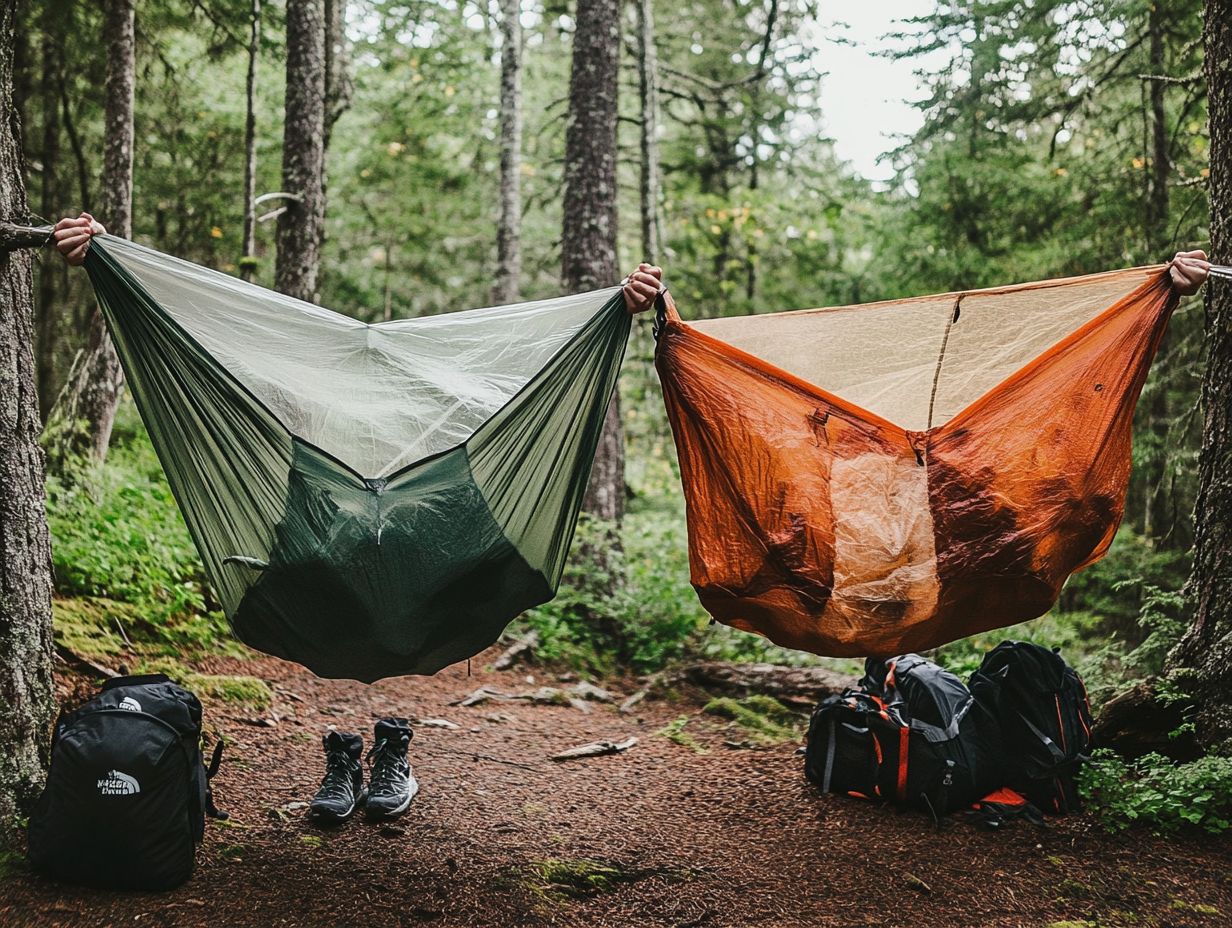
Choosing the right camping hammock is essential for your adventure! Several key factors can greatly influence your outdoor experience.
Consider your comfort needs, weight limits, and features like bug netting to ensure your time in the wild is enjoyable.
Understand how suspension straps and accessories like under-quilts and rain tarps can enhance your experience. These additions provide both stability and warmth while you unwind in nature’s embrace.
Factors to Keep in Mind
When selecting a hammock for your camping adventures, such as a Colombian hammock or a quilted hammock, there are several key factors to consider for a comfortable and safe experience.
First, think about the fabric type. You ll want to choose breathable cotton for warm nights or durable nylon that can withstand the elements.
The dimensions of the hammock are equally important. They can affect how well it fits between trees and how it supports your movements. A larger hammock offers plenty of room to stretch out, while a compact option is easier to transport.
Don t overlook the weight capacity, especially if you plan to carry extra gear or share the space with a friend. Researching setup instructions and using eco-friendly accessories like tree-friendly straps can enhance your stability while protecting the environment.
This way, you can ensure your hammock experience is not only enjoyable but also sustainable.
Setting Up Your Hammock
Properly setting up your hammock is vital for ensuring both safety and comfort during your outdoor adventures. Start by selecting an ideal location with two sturdy trees at an appropriate distance apart to accommodate your hammock.
Using high-quality suspension straps, securely attach your hammock to the trees. Ensure it is elevated enough to stay dry, even when the weather turns. With this setup, your hammock becomes the perfect shelter for any adventure!
Step-by-Step Guide for Proper Setup
To set up your hammock effectively, start by gathering all the necessary components, including suspension straps and bug netting. First, identify two trees spaced about 10-15 feet apart with a sturdy circumference to safely support your weight.
Using the suspension straps, secure the hammock at a height that allows for easy entry and exit. This height should also consider your comfort needs and ensure any bug netting is properly attached to keep the insects at bay.
Choosing the right trees is crucial; sturdy ones will significantly enhance your stability and safety while you unwind. Look for trees with bark-free sections to prevent wear on the straps. Be mindful of any overhead hazards, like falling branches, ensuring your setup remains safe and secure.
When securing the straps, aim for a height of about 4-5 feet off the ground for most adults. This height allows for a gentle sag that s perfect for lounging.
Always double-check the knots you use; loose ties can lead to unexpected tumbles. Ensure they re tight and secure. Adjust the distance between the hammock and the ground based on your lounging preference, but keeping an angle of around 30 degrees is essential for optimal relaxation.
Tips for Comfort and Safety
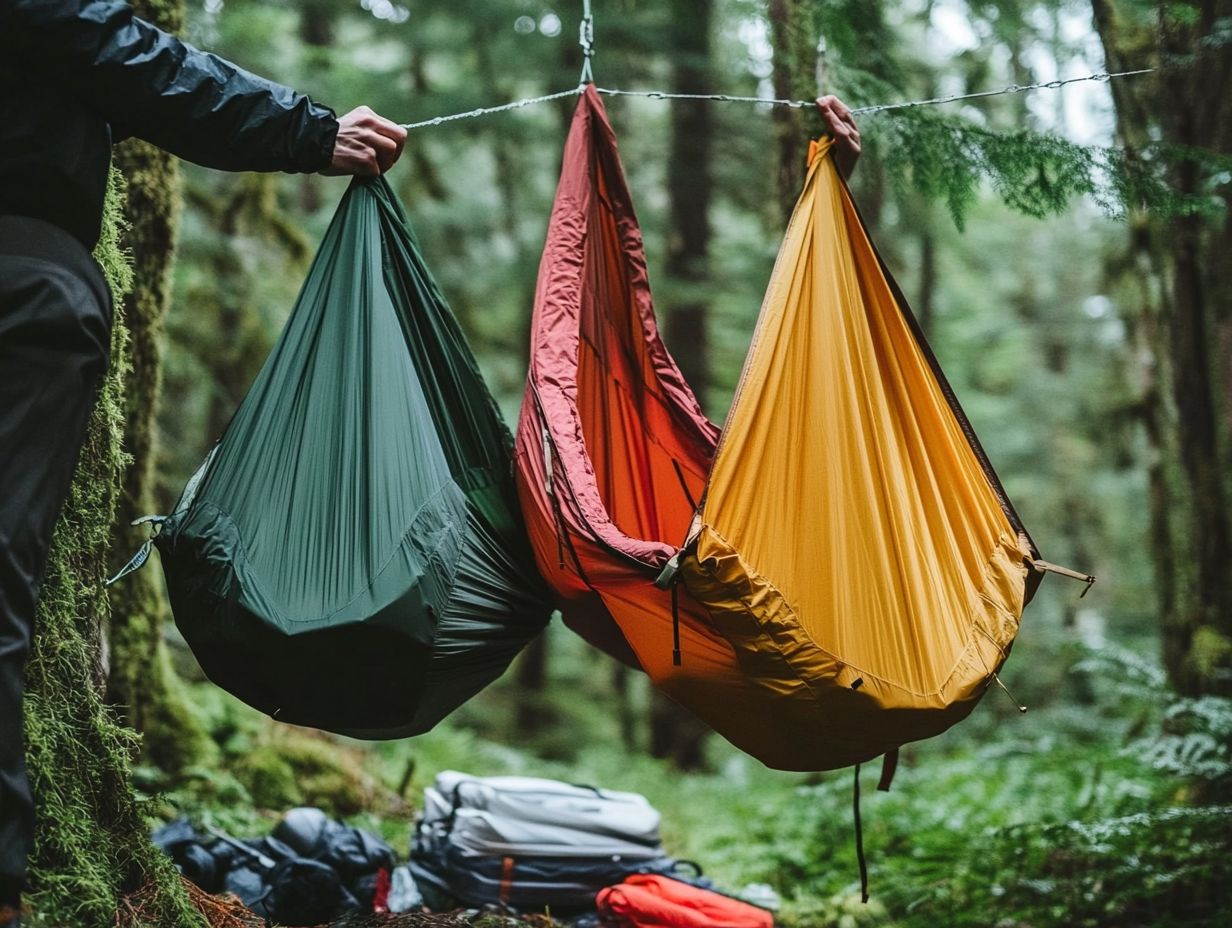
Prioritizing comfort and safety while hammock camping is essential for a truly rewarding outdoor experience. Several key tips can help you achieve this.
First and foremost, ensure that your hammock offers ample space to meet your comfort needs. Cramped conditions can turn a pleasant retreat into an uncomfortable experience during extended stays.
Incorporating accessories like an under-quilt and bug netting enhances comfort and shields you from unpredictable weather, making your shelter both more durable and enjoyable.
How to Stay Comfortable and Safe While Hammock Camping
To ensure a truly enjoyable experience while hammock camping, balancing comfort and safety is key for an amazing experience. This is especially important during summer excursions in locations like the Galapagos or Nicaragua.
Start by choosing hammocks crafted from lightweight materials that provide breathability and weather resistance. This allows you to feel comfortable in any season. Don t forget to prioritize bug netting to protect yourself from pesky insects. Enjoy the serenity of nature without distractions!
Selecting the right suspension system is just as crucial. It directly impacts your stability and ease of use. Ensure you can quickly set up your hammock for those spontaneous camping trips.
Seek out tree straps made from durable materials that won’t harm the bark of the trees. They should come with multiple attachment points for versatile setup options. A rain fly is a non-negotiable item to shield you from unexpected downpours. Don t miss out on a comfortable night; invest in a rain fly!
Consider packing a small gear hammock as well. It s an excellent way to keep your essentials off the ground, creating an organized and safe space that enhances both comfort and efficiency during your outdoor retreat.
Maintenance and Care of Camping Hammocks
Maintaining your camping hammock is essential for extending its lifespan and ensuring you experience peak performance during your outdoor escapades. By incorporating regular care such as proper cleaning and thoughtful storage you’ll preserve the material quality, allowing features like bug netting and weather resistance to shine.
Dedicating time to inspect the suspension straps and overall structure can help you circumvent unforeseen issues. This guarantees that your hammock remains a reliable haven for comfort in the great outdoors.
Keeping Your Hammock in Good Condition
To keep your hammock in great shape, follow a simple maintenance routine. Regularly check for any signs of damage or fraying, especially where the bug netting attaches and around the straps.
Clean the fabric with a mild detergent and dry it properly to maintain its quality. Store your hammock in a cool, dry place to protect its weather-resistant features.
Check the attachment points and suspension systems periodically. If your hammock sees a lot of sun, invest in a UV-resistant cover to prevent fading and wear.
When cleaning, avoid harsh chemicals to keep the fibers safe. For detachable parts like rain flies or underquilts, inspect and wash them according to their specific care instructions.
By following these simple tips, you can enjoy relaxing afternoons in a hammock that looks and feels wonderful for years!
Frequently Asked Questions
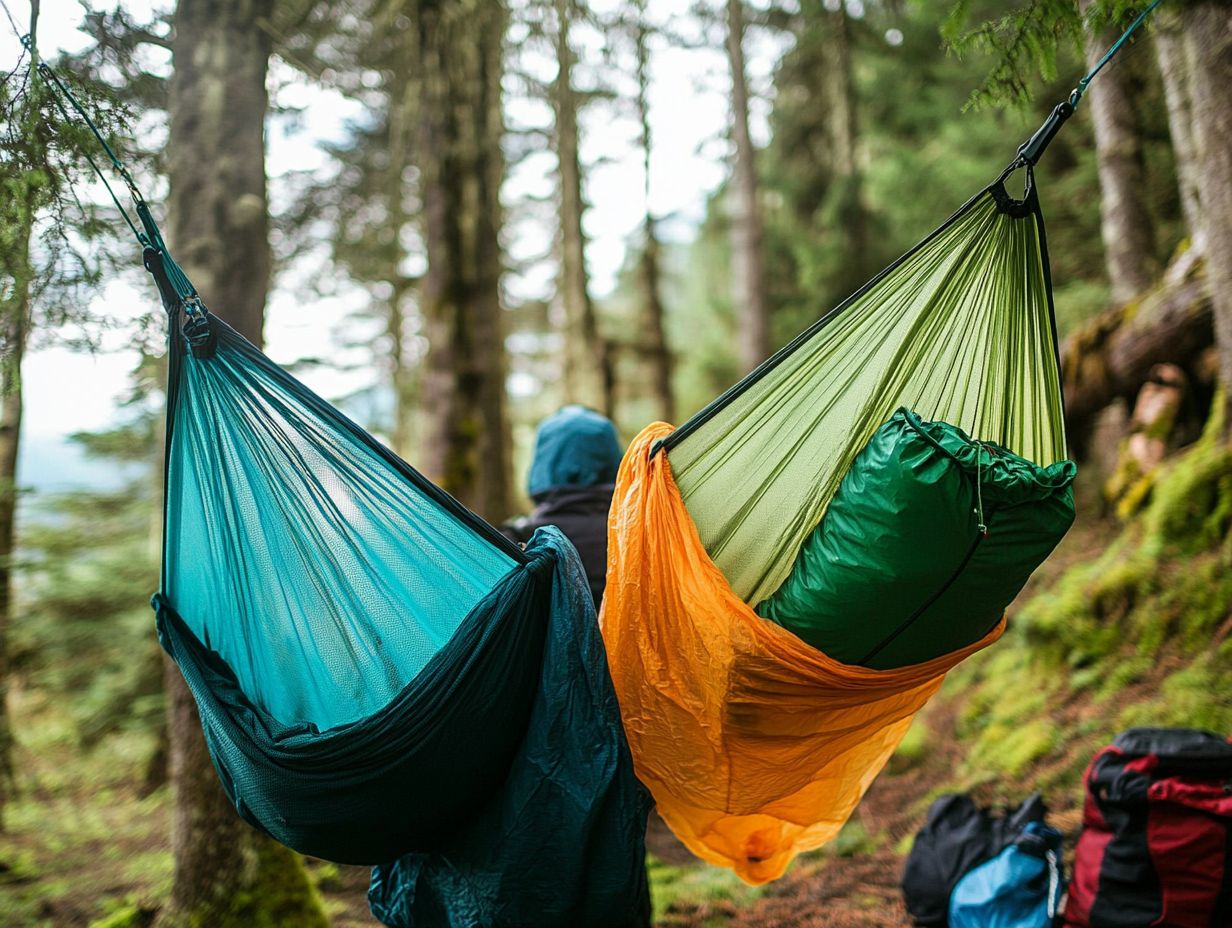
What are the key factors to consider when choosing a hammock for camping?
When choosing a hammock for camping, consider the material, weight capacity, size, and suspension system. Features like bug nets and rainfly can also impact comfort and functionality.
What materials should I look for in a camping hammock?
The most common materials are nylon and polyester. Nylon is lightweight and strong, while polyester is more durable and resistant to UV rays.
What weight capacity should I choose for a camping hammock?
Hammocks usually support between 200 to 500 pounds. Choose a capacity that covers your weight plus any gear for safety and durability.
How do I determine the right size for a camping hammock?
Hammocks are measured by length and width. A good rule of thumb is at least 9 feet long and 4.5 feet wide. Taller or wider campers might prefer larger sizes.
What are the different types of suspension systems for camping hammocks?
The common suspension systems include straps, ropes, and whoopie slings. Straps are user-friendly, while ropes and whoopie slings are lighter and adjustable.
Are there any additional features I should look for in a camping hammock?
Some hammocks have extra features like bug nets and rainfly. These help keep insects and rain out, but can add weight and cost. Think about your camping environment to decide if you need them.

